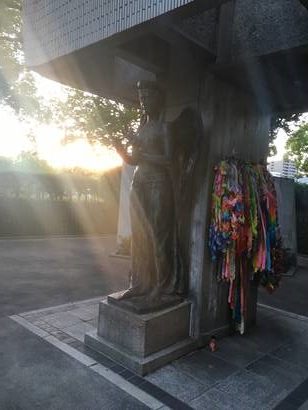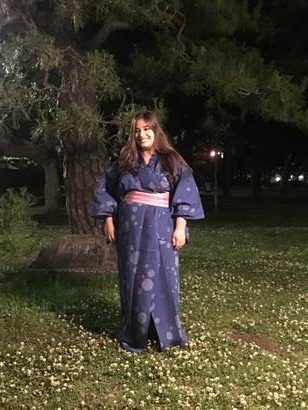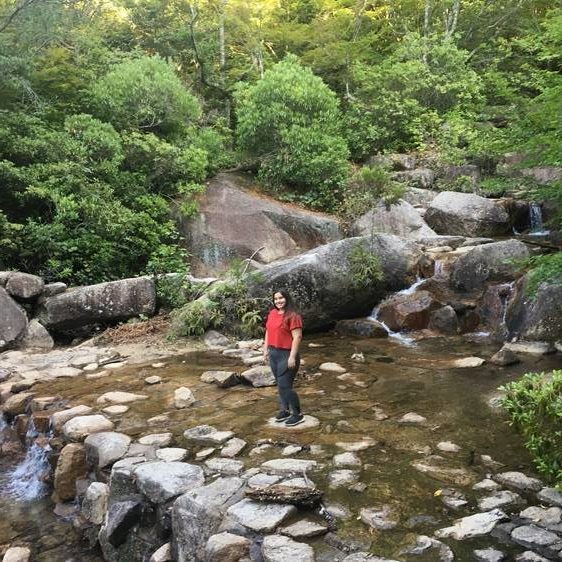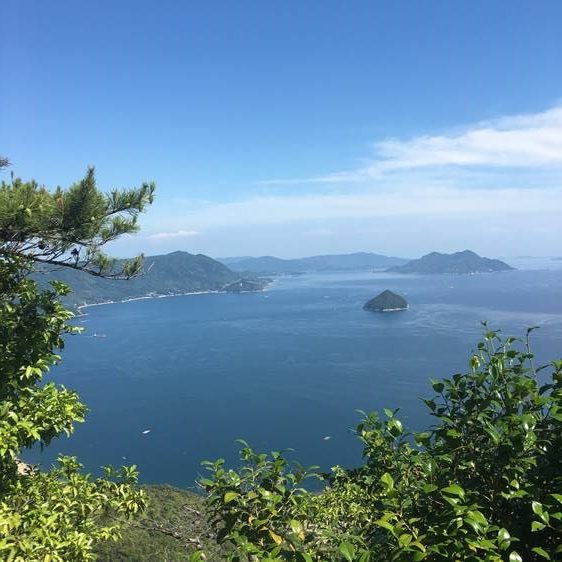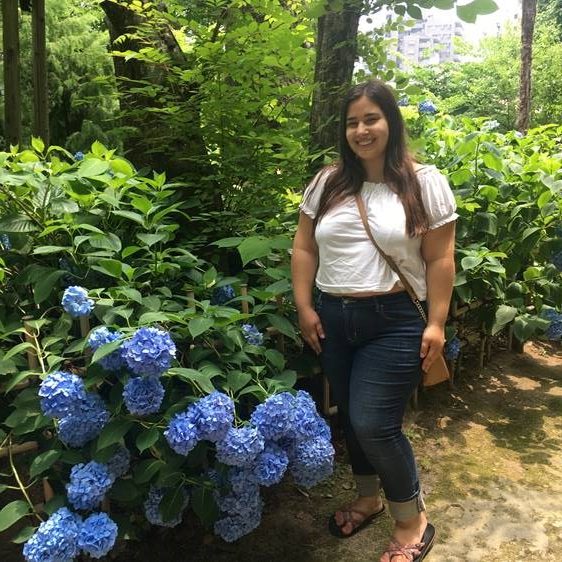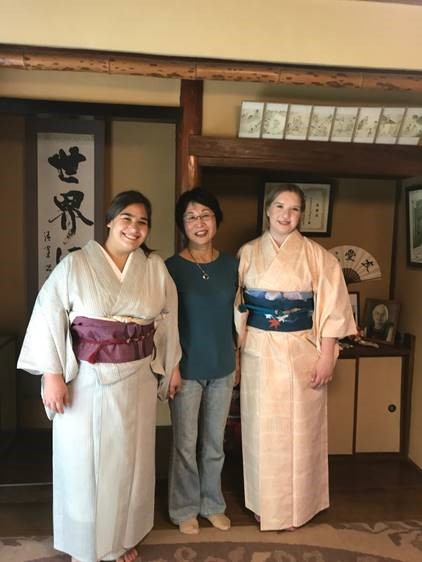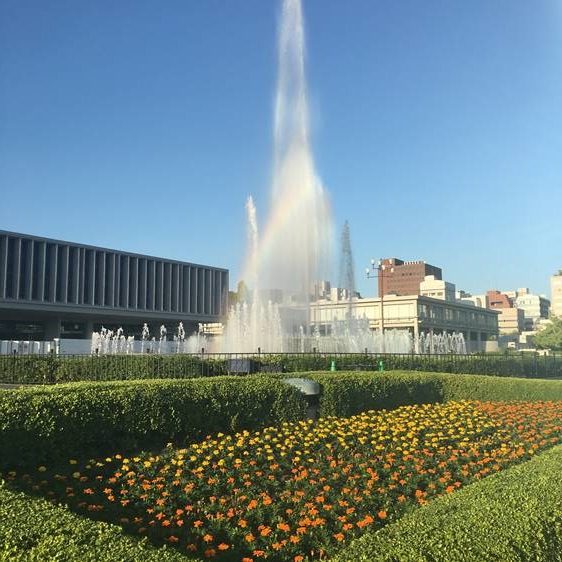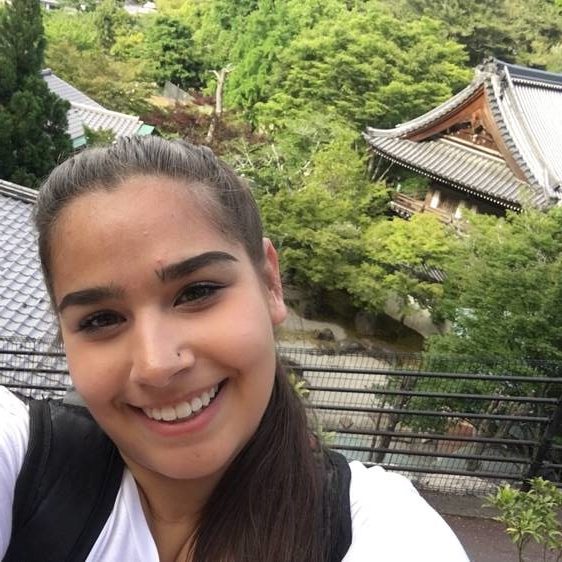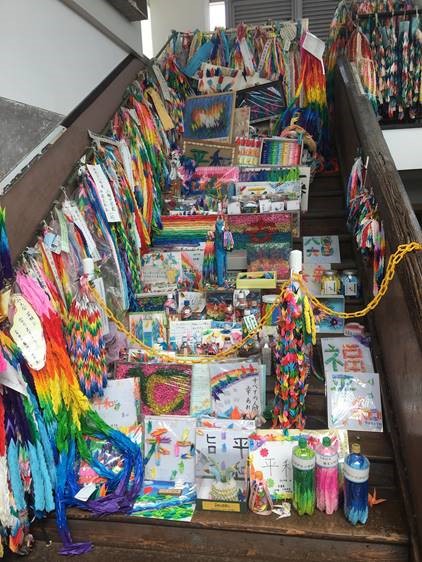2019
Yu-Ai December issue 2019 — WFC Reflection by Natalie Kuca
Yu-ai Friendship
Newsletter of the World Friendship Center, NPO
WFC Reflection
Natalie Kuca
(Translated by Mikiko Shimizu)
At the end of May, one of the WFC board members, Tachibana-san invited me to visit a social welfare center in the area that had history with zainichi Koreans, which was one of my fields of interests in Japanese studies. Tachibana-san had worked in the day care at the center, and he was able to arrange for the director of the center to give us a tour of the facility and tell us about its history. By the end of the meeting, my interest was piqued and I offered to volunteer at the center once a week. My first Friday at the center was a bit overwhelming and I was very nervous as no one spoke English, so I was forced to rely on my own Japanese skills. I worked with first and third-grade students in the after school program and I found that I was so nervous that I often couldn’t communicate with them in Japanese. Most of the children were shocked by my appearance and multiple students asked me whether I was Japanese and were even more shocked when I replied that I was America. They were very shy when approaching me and whispered “gaijin,” or ‘foreigner’ in small groups. Slowly, a group of girls became comfortable around me and they began to ask various questions about my family and flying on an airplane while pawing my blonde hair and staring at my blue eyes. My second Friday at the center was noticeably more relaxed as everything and everyone finally looked familiar to me. I even found that I was much more comfortable speaking Japanese as well. Granted, these were first and third-grade students, but my comprehension of their fast-face Hiroshima dialect had significantly improved.
Additionally, on the third Thursdays of both May and June, Yovana, Barb, Dannie, and several WFC board members volunteered at a hibakusha retirement home. The first day at Mutsumien was enjoyable because both Yovana and I were able to introduce ourselves in Japanese on the stage and then were able to watch Hawaiian hula dancing by a local amateur troop. For June, the chairwoman of the WFC, Michiko-san asked us to prepare a small activity for the members of the retirement home. Naturally, Yovana and I decided on bingo, which is an enjoyable gave for people of all ages. We prepared three small prizes for the winners and had a lot of fun shouting the numbers in Japanese and cheering for the winners. The grannies were so excited when they won their WFC pens as they weren’t expecting anything as a reward.
Yovana and I were entrusted with an important responsibility during our fifth week in Hiroshima. The co-directors had planned to take this weekend off and left Yovana and I in charge, and we were very honored by their trust in our abilities. Barb and Dannie left on Saturday morning, but Yovana and I prepared breakfast for nine people all by ourselves. Luckily, Leona and Maila, along with their mother, Mirei, were staying at the WFC for a performance that weekend and were able to help relieve our anxiety and took some of the pressure off being in charge. We were able to prepare breakfast with no problems, and had incredible discussions with our Californian guests during the meal. The easy-going nature of this group of guest was a great relief for everyone, and we were able to proceed with the weekend with minimal issues. The groups’ scheduled hibakusha survivor, Soh-san gifted us with his handmade fans and handcrafted wooden pencils made from his own cherry trees. His generosity exemplifies the overall compassion and generosity everyone at the WFC has shown us. Yovana and I have taken to calling the board members of the WFC our sweet grannies because they constantly spoil us with fun conversations and stop in to give us fruits and sweet treats.
In addition to our Monday and Tuesdays at Shudo University, we also join in on a WFC English class on Wednesdays. I have been particularly impressed time and time again with the proficiency and fluency these students demonstrate every class. Their class begins by a presentation made by one of the students, which oftentimes include history of post-war Hiroshima or their family member’s experiences during the bombing in English. This class in particular maintains a mandatory break where they serve tea and they share snacks with one another. The second half of the class includes the reading of an autobiographical account of Shinzo Hamai, the mayor of Hiroshima that fought for reconstruction, again in English. I find that this type of learning is especially effective in helping students with retention of new vocabulary and comprehension. In fact, I have become so inspired by this technique that I am planning on purchasing a couple of Japanese books and trying to translate and read these novels on my own.
Yovana and I were given the incredible opportunity to hear ten hibakusha testimonials. These testimonials detail accounts of the same humid early-August morning seventy-three years ago, but the experiences of each hibakusha and the lessons and challenges they confronted all manifested in different ways. Their powerful and emotional stories forced me to realize the importance of denuclearization movement. When I was learning about the Pacific Theatre of WWII in high school, I was under the impression that the atomic bombings of Hiroshima and Nagasaki were irrevocably necessary to bring an end to a decade of war in Asia. During a discussion in history class, I had even taken the side of the American government and stated that the bombing had been necessary. The real problem for most Americans is that the education on the end of the war with Japan is incredibly biased. The Japanese citizens are painted as ferociously devoted to their emperor and their militarist government that, in the case of an American invasion, the women and children would attack American soldiers with bamboo spears. America argues that millions of young American lives would have been taken in the fight for Japan and they claim that Hiroshima and Nagasaki are demonstrations of what would have happened to all of Japan. In history textbooks there is little to no mention of the fire-bombing of the two dozen largest cities in the months leading up to American encroachment of Japan. During these bombings, hundreds of B-24s and B-29s razed cities to the ground until they resembled the images of Hiroshima and Nagasaki that textbooks like to point to as a demonstration of American power. The difference between the fire and atomic bombings is that the latter were carried out by a single bomb, rather than thousands of them. These history books also fail to mention that the American navy had completely encircled Japan, preventing the import and export of valuable resources for their citizens and soldiers on both sides. Though students were mobilized to farm food and other resources in the countryside, and were often trained to resist possible invasion with bamboo spears, Japan was starving and women and children were dying from malnutrition at the time of the atomic bombing. Furthermore, the physical devastation of the atomic bombings, not including the unknown devastation of radiation posioning, was almost identical to the thirty other large cities in Japan that were fire bombed. The atomic bombings of Hiroshima and Nagasaki, I have learned, were not as conclusive of Japanese defeat as our history books claim. The radiation, which effects come later, is the most devastating outcome of nuclear warfare and nuclear disasters.
The resilience of the hibakusha, and the rest of Japan after the war, was particularly inspiring to me. Though the bombing and its effects were harrowing, the survivors survived because they were all able to find something and someone to continue living for. I believe that such devastation is an important piece of survivors, but it does not consume their entire soul, there are many more pieces that create who they are and how they choose to live their lives. All the hibakusha have maintained that they wish for worldwide peace and for complete global denuclearization, not to compensate themselves but in order to prevent more people, more innocents, from suffering from the inevitable devastation nuclear weapons and nuclear disasters present.
As we began our last week in Hiroshima, Yovana and I both found it difficult to imagine going home when we were so in love with Hiroshima. The people we have met here have made everlasting impressions and the history we have learned here will continue to persuade us into peace activism in our communities back in the States. I have grown a lot during this internship and am eternally grateful for the opportunity I have been granted and I will work hard not to squander it.
Copyright © NPO World Friendship Center 2019 All Rights Reserved
Yu-Ai December issue 2019 — Experiencing Hiroshima through the World Friendship Center by Yovana Milosevic
Yu-ai Friendship
Newsletter of the World Friendship Center, NPO
Experiencing Hiroshima through the World Friendship Center
Yovana Milosevic
(Translated by Sumiko Kanetsuna)
Briefly living in Hiroshima, Japan and staying at the World Friendship Center is easily the biggest blessing in my life. I encountered an entirely different culture by living in it for a month and a half, and there were surprises waiting for me at every corner. I was able to participate in daily discussions involving peace, compassion, kindness, and debates on current world issues. I attended numerous lectures on not only Hiroshima’s history specifically, but also about how it has been represented in the media over time, what the current nuclear situation is, which countries do and do not possess nuclear warheads, current problems in Israel-Palestine, and the influence of Fukushima in modern politics.
In addition to these riveting and relevant lectures, I heard several accounts of what happened the day of August 6th, 1945. I was able to have conversations with people who survived that day, and all the days after. There was a palpable sense of resilience and love radiating throughout WFC, and now that I’ve returned, that is one of my strongest memories.
The hibakusha faced the world’s most hideous atrocity, yet they live their lives focusing each moment on peace. They have devoted their lives to spreading peace, and this is not a sentiment anyone should take lightly. It is difficult to find positivity and hope for the future during such turbulent political times, yet the people at WFC make this their purpose. I was constantly inspired at WFC, and my hope for the future is that we all (myself included), take on the responsibility of actively advocating for peace. I appreciate the World Friendship Center, their English classes, the lovely members, and all of the profound experiences I had this past summer.
Copyright © NPO World Friendship Center 2019 All Rights Reserved
Yu-Ai November issue 2019 — Observation tour to Tottori Yonago Solar Park and Pumped-Storage Hydroelectric Power Station
Yu-ai Friendship
Newsletter of the World Friendship Center, NPO
WFC Peace Seminar Activity Report
Observation tour to Tottori Yonago Solar Park and
Pumped-Storage Hydroelectric Power Station
by Asaka Watanabe
(Translated by Mikiko Shimizu)
Six members of the WFC Peace Seminar including the lecturer, Syoji Kihara, went on a trip October 22nd and 23rd.
It was a tour to learn from a variety of places, such as –
- the circumstances of the Shimane nuclear power plant
- an observation tour of the Matanogawa Pumped-Storage Hydroelectric Station between Tottori and Okayama
- Tottori Nature and Environment Center which is a base of Tottori
- Soft Bank Tottori Yonago Solar Park
- Yonago Waterfowls Park, among others.
We listened to a lecture by Hitoshi Doko at his own tea house. The tea house “Yodoemon” uses an unoccupied house in front of his home in Yodoe-cho. We enjoyed delicious cakes and coffee there. Hitoshi is a councilman from Yonago who pursues the goal of denuclearization. His talk started with a quiz asking us where the Shimane nuclear power plant was located. Then, he told us about an evacuation route to be used if a very bad accident occurs. He indicated a problem for the entire Japanese island, because radioactivity would move downwind according to the direction of the wind – usually a wind from the west.
Tottori Nature and Environment Center is managed as a core institution for environmental education. The highlight is the Soft Bank Tottori Yonago Solar Park, which spreads out next to the center and is the largest solar power facility in Japan. The amount of electrical production is equivalent to that consumed in a year by approximately 12,000 ordinary households. Tottori Next-Generation Energy Park consists of over fifty facilities producing power from solar energy panels or hydropower or wind power. An eco-tour around the facility and other local sites was also provided.
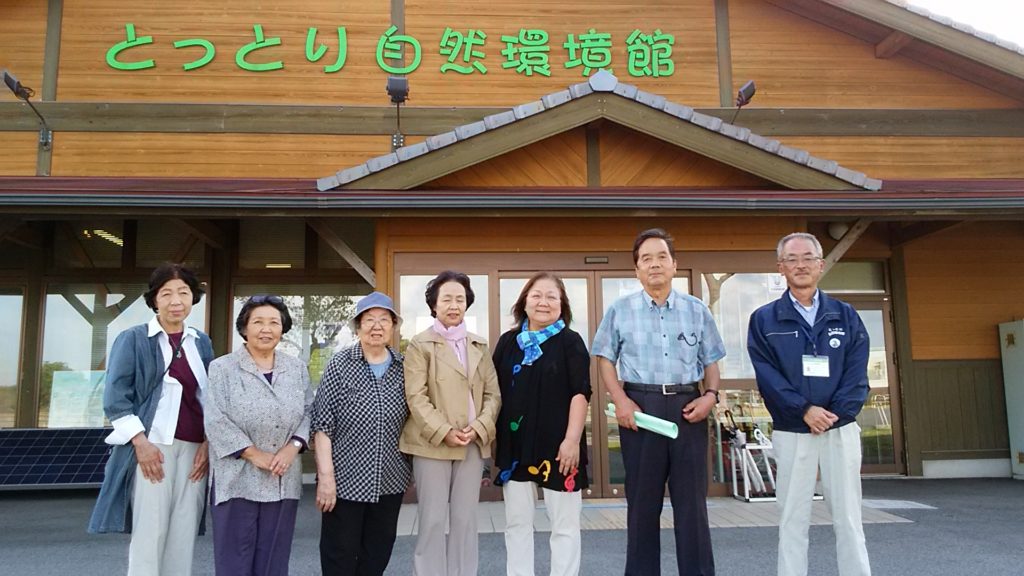
The Nature and Environment Center keeps a family of three goats to eat weeds. To help feed them, we picked leaves of the Kuzu vine (Pueraria lobate) on the river bank to give to the animals. As a side note, the Center does not use any herbicides, and the goats are actually more popular with the children than they are useful at eating weeds.
Near Nakaumi is Yonago Waterfowls Park, one of the best wild fowl habitats in western Japan. Here you can find nearly 42% of all the types of wild fowls found in the nation. These amount to about 120 kinds of wild fowl and more than 10,000 total birds. Yonago Waterfowls Park has been operating as an institution, with the assistance of concerned citizens, who together help protect and preserve nature. We enjoyed observing water fowl through a telescope in the observation hall while listening to a volunteer instructor’s explanation. A wintering place for a whistling swan group is located at the southern border of Japan. Unfortunately, we couldn’t see the graceful fowls in their group as they had swum out for food.
The next morning, we visited Matanogawa pumped-storage hydroelectric power station, which was the main purpose for this trip. Matanogawa dam produces 1,200,000kw by using the 500m difference in the height of the upper and lower dams. The upper reservoir (Doyoh dam in Shinjho-mura, Okayama) and the lower reservoir (Matanogawa dam koufu-cho in Tottori) are large-scale facilities connecting both prefectures – Okayama and Tottori. There is an underground power house located beneath the lower reservoir, where the electric power is produced in daytime. Water is pumped up at night time by reversing the rotation direction of a reversible pump-turbine and generator motor.
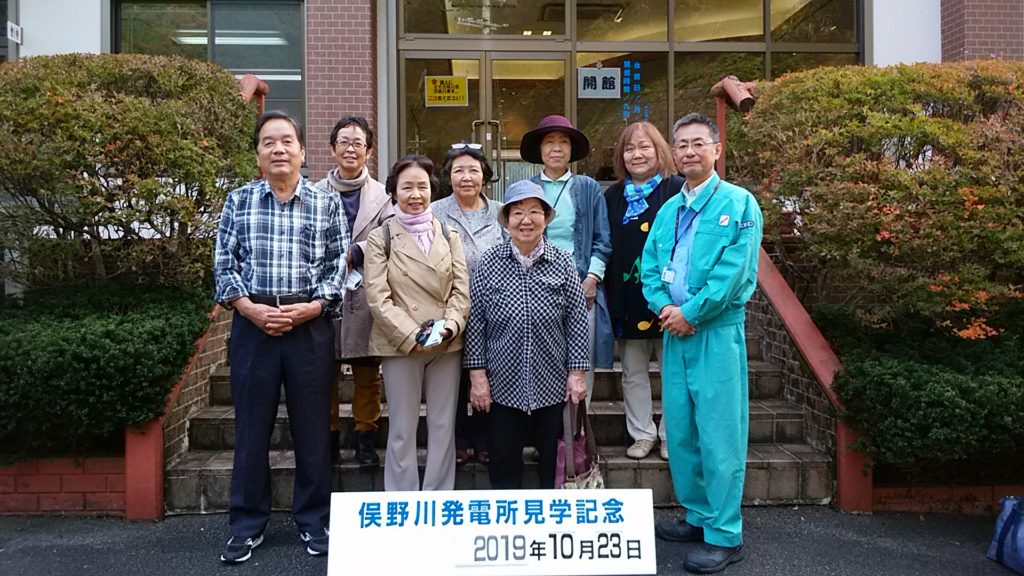
The pumped-storage hydroelectric power’s role is to make up for the difference in demand because it changes depending on the season, time, and day. It also changes in dry weather by using solar energy generation. Quite simply, the plant plays a prominent role in charging or discharging a large rechargeable battery.
During the night when the usage charge is less, water is pumped up from the lower reservoir using the electric power from the thermal power stations or the nuclear power stations. The electricity in the daytime, when it is in great demand, is produced by dropping water into the lower reservoir from the upper reservoir and adjusted to the demands of consumer power. It is then sent as electricity to homes or factories. It takes 7 hours to create electricity by dropping water from the upper reservoir to the lower reservoir and 10 hours to pump it up from the lower reservoir to the upper reservoir. Though it might seem to be a loss of 3 hours, this gap in time is necessary to maintain a stable supply of electricity.
Chugoku Electric Power Company has Matanogawa pumped-storage hydroelectric power station and two other pumped-storage hydroelectric power stations – Shinnariwagawa in Okayama (with a power capacity of 303,000kw) and Nabara in Hiroshima (with a power capacity of 620,000kw.) I thought that the mechanism to balance production of electric power by using different sources was very interesting.
The leaves around the pumped-storage hydroelectric power station have already begun to turn to fall colors. There seemed to be a chance to meet monkeys, deer and wild boar, maybe even a bear……unfortunately, we couldn’t see the underground power house this time because of ongoing construction.
We saw a catch-phrase of “Riches of Abundant Nature, Tottori” written in a pamphlet. I felt that the effort toward nature and the environment which Tottori is undertaking – repeating trial and error time after time – will become the theme of living and be passed on to the next generation. This was our educational trip to be applied in a variety of ways in our future activities.
It was beautiful weather! We spent time in a relaxed atmosphere sharing lunch, which we got at the road station, “Takano”, and took in a scenic overlook of Lake Shinjiko. We stayed in a hotel called “Unabara Soh” one night and enjoyed a hot spring, delicious meal, and conversation. It recharged our energy!
When we came back, we drove in Bihoku Hillside National Government Park; unfortunately, we couldn’t see the field of cosmos flowers – it had closed a day before. After eating lunch at a restaurant in the park, we stopped by Miyoshi boutique winery to buy some souvenirs and left for home.
Dear Syoji Kihara,
Thank you so much for planning, preparing, and driving on the trip, with plenty of attention to us.
We offer our heartfelt thanks.
In writing this report, I used many phrases and thoughts of the participants’ emails.
Copyright © NPO World Friendship Center 2019 All Rights Reserved
Yu-Ai October issue 2019 — One Friend at a Time by Barbara Shenk
Yu-ai Friendship
Newsletter of the World Friendship Center, NPO
One Friend at a Time
Barbara Shenk
In August, 2017, Hiroshima became our home, to a much greater degree than we could have imagined. Many wonderful people involved in the World Friendship Center and beyond quickly befriended us. The more we learned of Barbara Reynolds and the mission of WFC, the more it became our mission. Sharing this mission with the 800 or so guests we hosted, over 1600 or so breakfasts we served, confirmed to us that peace is fostered “one friend at a time.” As we walked and bicycled in and around the beautiful city, we discovered almost magical places for relaxation and refreshment. We already miss all these aspects of our two busy years at WFC.
We miss the English classes where we read and discussed literature and histories together. In these classes we learned so much about the daily lives and interests of our students and about special customs and places in Hiroshima and Japan. And we laughed a lot.
We miss the breakfasts with our guests where we had great discussions about war, peace, cultures, politics, and personal experiences. Having guests from different parts of the world connect over breakfast was particularly satisfying. Sometimes they would make arrangements to meet each other again.
We miss the warm friendships of the WFC board members and many others who came to support us and participate in the mission of WFC in whatever way they could. This included helping with cleaning, bringing food, translating, editing, carrying away and disposing of unneeded items, improving the WFC website, taking guests or interns to the doctor, painting, sorting through books and documents, and moving furniture.
We miss the beauty of Hiroshima, from the rivers which were our daily companions, to Miyajima, the Inland Sea, the mountains, and perhaps as much as anything, the Mitaki temple complex and hills. We also miss the oysters, okonomiyaki, and all the other wonderful foods of Hiroshima.
Perhaps the most rewarding aspect of our work in Hiroshima was witnessing the interactions between our guests and the hibakusha who came to share their stories. Our guests were moved beyond words and often told us that this experience changed their lives forever. It is impossible to calculate the effects of these guests retelling the stories back in their home countries.
From the bottom of my heart I wish to thank all of you who enriched our lives immeasurably over our two years in Hiroshima. We will never forget you or the mission we share.
Copyright © NPO World Friendship Center 2019 All Rights Reserved
Yu-Ai October issue 2019 — Reflections on Hiroshima by Dannie Otto
Yu-ai Friendship
Newsletter of the World Friendship Center, NPO
Reflections on Hiroshima
Dannie Otto
It is difficult to write about my experiences in Hiroshima, because when I think about the past two years, my mind is flooded with memories. We met many wonderful people. First of all, the Hiroshima people who are involved with WFC and contribute so much time and energy to the work of the center. In addition, there were the many interesting guests who came from many countries to learn about the effects of the atomic bomb on Hiroshima. At times it seemed like we lived in two worlds. On some days, we would spend time with our international guests, serving them breakfast and then telling them the story of Barbara Reynolds and her work for peace and nuclear disarmament. Immediately after telling the Reynolds story, I would go to meet with local members of WFC in an English class where we would also reflect on the effect of the bomb on Hiroshima. I wish we could have brought these two groups of people together.
We enjoyed all of our international guests, but there were several who stand out in my memory. In February of our first year, a time when we were not very busy with guests, we received a request from a woman for a party of two, male and female. The reservation was on short notice but she was persistent that we could assure her that they could hear the story of an A-bomb survivor. When they arrived, we had time for tea and conversation together. After introductions, the woman asked if we ever have people in the military visit us. I couldn’t think of any but assured them that military people would be welcome. She then urged her male friend to tell us what he did. Eventually he told us that he was active duty in the U.S. Air Force and served in the Strategic Air Command where his job was to develop the programming to guide American nuclear armed bomber jets to their targets. His job was to develop a detailed checklist to guide bomber pilots from their base in Louisiana to the potential targets. His friend then interjected that they had come to Hiroshima and WFC because she wanted him to understand what would happen if there were another nuclear war.
The following day our two guests heard a survivor story, toured the Peace Memorial Park with a WFC guide and then visited the museum. In the evening he and I talked late into the night about war, the threat of war and the nature of peace. The next morning, they left. We never learned his name. He indicated that his superiors in the Air Force would not be happy if they knew of his visit. We never heard from them again. I often wonder if his visit to Hiroshima and WFC changed his views on his job.
Barbara Reynolds set the mission of WFC as “Fostering Peace, One friend at a time”. We believe that this is an important mission and the example of our encounter with a member of the Air Force is one example of how we can engage people on a personal level with serious conversations. I am very grateful to WFC for giving me the opportunity to engage in peacemaking in this very personal way.
Copyright © NPO World Friendship Center 2019 All Rights Reserved
Yu-Ai September issue 2019 — New Directors Roger & Kathy Edmark
Yu-ai Friendship
Newsletter of the World Friendship Center, NPO
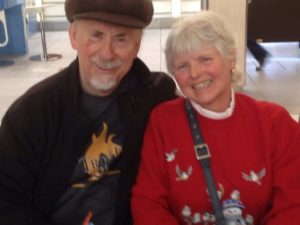 Greeting from Roger and Kathy Edmark, new co-Directors of the World Friendship Center. We have now been in Hiroshima for over a month and are enjoying our time at WFC. We would like to thank all of the staff and volunteers at WFC for the warm welcome we have received.
Greeting from Roger and Kathy Edmark, new co-Directors of the World Friendship Center. We have now been in Hiroshima for over a month and are enjoying our time at WFC. We would like to thank all of the staff and volunteers at WFC for the warm welcome we have received.
Roger Edmark
I was born in North Dakota, in the USA. Before I was one year old, my parents moved to Seattle. They packed up my older sister and me in the car and drove to Seattle to look for milder weather and better employment opportunities. Within one week, my father was employed by the Boeing Company. Twenty-two years later, I too would be employed by Boeing.
All of my schooling, grade school through high school, was in Seattle. My favorite activity as I grew up was playing baseball which I did through High School. I have always loved sports (baseball, softball, basketball, golf and others) either participating, coaching, or watching it. After high school I worked for Norse Home, a retirement home in Seattle. I was a pot and pan washer. I continued to work there after enrolling at the University of Washington, also in Seattle. I first studied Architecture, but eventually received a BA in Philosophy. After graduating, I worked for the Boeing Company for 43-years, mostly in Aerodynamic Engineering. My job involved international travel, and Tokyo Japan was a frequent destination.
When I was in my 50’s, I was told by the doctor that I had a heart murmur. The murmur was caused by a congenital heart defect of my aortic valve. I would need to have it fixed if I wanted to live a normal active life. So, at 57 years of age I had an operation to replace the faulty valve with a new artificial one. Today, my heart works like a clock – it literally beats one beat per second. My grandchildren like to put their heads on my chest and hear the clock (heart valve) click away. The whole process was a reminder that there are no guarantees as to how long we live, so we need to cherish each day as it comes.
Kathy Edmark
I was born in Twin Falls Idaho. My parents accepted a call from the Christian church to go as missionaries to Miyako Jima when I was 4 years old. For the next 11 years I lived in Miyako, Kobe Japan and Okinawa with 1 year in Seattle. When I was 15 years old, I returned to Seattle where I completed my last two years of high school. I too got a job at Norse Home in my last year of high school, which is where I met Roger. Three years later, we were married.
My first job after getting married was in the home, which took all of my time until all four of our children were in school. I then answered a call to serve in our church for a couple of years as Christian education director. After that I became a para-educator in the school district our children were attending. I worked for the school district for 25 years.
One of my skills has been sewing. My grandmother started me sewing at a young age. The rest I learned from directions on patterns. I made and sold Barbie doll clothes as a first “job”. I made some of my own clothes as a teenager. I made my own wedding dress! One time I made outfits for all 4 of my children including a 3-piece suit for my son for a family picture. I did a lot of sewing for my daughter Aimee’s ballet school, including short tutus. I made my first daughter’s wedding dress and her attendants’ dresses. My second daughter would only let me alter her purchased wedding dress, to save me stress, but I had to take it apart to do that. Sewing has given me a great feeling of accomplishment as I take a flat piece of fabric and create something beautiful and or useful. I don’t sew very much any more because of hand pain but I have altered 4 of Roger’s shirts by hand stitching since we arrived. A useful skill.
My faith has led me to be very active in my church. I have been a Sunday school teacher most of my life, usually with children, but also with youth and young adults. Bible Study Fellowship, an interdenominational Bible study, was an important part of my life for 7 years. Part of that time I also worked in the children’s program. Two years ago, our daughter became the Food Services Director of a camp and conference center, Camp Koinonia, and asked if I would like to be her volunteer assistant. So, for about one year, we lived half our time at the camp and half the time in our home north of Seattle. The camp was in transition, so Roger became the Development Director there at about the same time.
Kathy and Roger
Two months after we were married in 1973, we were asked to be one of two security couples at another retirement home, Northaven. We lived there for one and one-half years. That began a 46-year relationship with Northaven. For 36 years, Roger has been a member of their board of directors and most recently as board President. He is now an Emeritus member of the board.
Our home church in Seattle is Olympic View Community Church of the Brethren. Church of the Brethren is a historic peace church in the USA. “Brethren Volunteer Service (BVS)”, a ministry of the Church of the Brethren, is how we learned about WFC. We have both been involved in many church leadership positions and church activities from the time our children were young.
As a family we loved to spend time in the outdoors. We did not do that so our children would love the outdoors, but that is what happened! They all love the beauty and wonder of nature! A favorite place today is the beach house where we have part ownership. It is on the water one hour north of our home. Kayaking, strolling on the beach, relaxing in the hammock and enjoying friends and family are all things we enjoy at the beach cabin.
Serving others is important to Kathy and me and our children have caught that bug as well. They have also chosen occupations and volunteer activities in their lives which serve others. Fifteen years ago, we learned about WFC and immediately were interested. We even came to WFC fourteen years ago when Roger had a business trip to Tokyo. We explored Hiroshima and stayed a night at WFC. We have a motto on a plaque at home which says “God does not ask about our ability or inability but about our availability.” We made ourselves available to WFC and were called to serve, so here we are! In the short time we have been here, we have met many wonderful people and have hosted many interesting guests. We have seen how valuable the mission of WFC is: to share a message of peace through relationship building, listening, storytelling, especially Hibakusha stories, and having a peaceful place for people to stay.
Copyright © NPO World Friendship Center 2019 All Rights Reserved
Yu-Ai May issue 2019 — Korean PAX report by Keigo Nakamura
Yu-ai Friendship
Newsletter of the World Friendship Center, NPO
Participating in the Korean Pax
Keigo Nakamura
I learned many things and experienced many meaningful days while participating in the Korean Pax. For example, I learned about military comfort women and Korea in the Japan colonial period. I’d like to tell about four of my most impressionable experiences.
First, on the morning of the second day, I saw demonstrations held in front of a military comfort women statue near the Japanese Embassy. Many people participated in the demonstrations due to the day falling on May Day, including many students. Some, wearing yellow dresses like Jakie Chan, hit something like a sponge ball which had a face photo of Prime Minister Abe on it, which was interesting. Girl students and women with
their children also participated. I thought they were more interested in politics than Japanese people. Enjoyable activities like dances and songs were performed during demonstrations. I was surprised and interested, thinking that those looked nicer than in Japan. However, I also felt sad to see mothers participating with their small children, exposing them to Anti-Japanese sentiment at such a young age. Moreover, I had a strange feeling that I would betray my country joining this demonstration.
Second, I visited the House of Sharing. I learned about military comfort women when I visited the historical museum located on the spot where the House of Sharing was founded. I was a little bit tense because some Korean army soldiers were there. I had thought that Military Comfort Women would be all Chinese or Korean. So, I was surprised to know that
there were Japanese military comfort women too. I had an opportunity to meet former military comfort women and to hear about many things. One said to me, “I am able to forgive the present-day Japanese who were not born when I was a comfort woman. I am glad to hear your apology, but you are not responsible. My heart is not healed.” Her words impacted me deeply. She said that she wanted the Prime Minister Abe and Emperor Showa to apologize to her which made me understand what severe sufferings she had undergone.
Third, I went to Gyeongbokgung Palace. I often have seen historical Korean plays on TV, and was glad to see close-up the historical building which I saw in the TV program. I realized again that the Korean Palace was splendid. This was my second time to visit Seoul and Gyeongbokgung. I saw more black people and Westerners than the last time. I realized that Korea has become globalized.
Fourth, I experienced interaction with the host family in Korea. I was treated to Korean food – dak galbi on the second day of my visit, and to samgyupsal on the third day, as well as a Korean alcohol, mak goeli. While drinking together at that time, we talked about my grandfather and politics. Through this conversation, I learned about historical Korean plays, Korean children’s songs and the educational system of Korea. I had a friendly conversation with the host mother because both of us had something in common, learning Chinese a little. Given a lot of good sightseeing advice, I spent an enjoyable time while I was free on the fourth day.
Allow me to use this opportunity to apologize for having troubled many people when I got on the wrong train when I changed trains and got lost. I learned many things and had a valuable Golden Week. Karen invited me to participate in a summer camp in Nanjing which I’d love to do. I’d like to express my deepest gratitude to the host family in Korea, people of the Peacebuilding group that accepted the Korean PAX, and members of the WFC.
Translated by Sachiko Hiraoka
Copyright © NPO World Friendship Center 2019 All Rights Reserved
Yu-Ai May issue 2019 — Korean PAX report by Matsue Matsumoto
Yu-ai Friendship
Newsletter of the World Friendship Center, NPO
Participating in the Korean PAX
Matsue Matsumoto
I participated in the Korean PAX from April 30 to May 5. During this trip, I visited places where we usually could not go, and had very valuable experiences.
I participated in a protest meeting which was held in front of the Japanese Embassy on Wednesday May 1. The protest meeting is held on every Wednesday. In the afternoon, we went to Seodaemun Prison History Hall. On May 2, we visited the Comfort Women Historical Museum and met a Korean woman at House of Sharing. They both depicted negative legacies of the Imperial Japanese Army.
At the anti-Japan demonstration on Wednesday, a priest of the Methodist church offered his message and prayer. I couldn’t understand Korean, so I had no idea what he was saying. In the bible, Matthew 5:44 says “Love your enemies! Pray for those who persecute you!” I couldn’t understand what kind of message he offered and how he prayed for people in the demonstrations.
At the site of Seodaemun Prison History Hall, prison houses are preserved and open to the public. Activists in the independence movement were imprisoned here during the Japanese colonial period. The prison houses were also used by the Korean government after World War II. They were the buildings where tortures and death penalties were performed.
At House of Sharing, Tsukasa Yajima, a Japanese, showed us a video of the activities and protest of Ms. Kang Duk-kyung who was the first to proclaim the comfort women issue. We saw her pictures that she drew for her mental health. Each picture depicted her crying heart – a feeling I could share. After that, I met two Korean women. Their names and ages were the same. One of them looked calm as she told her story. I thought she had a strong will which would not be daunted and would persevere through anything. When I asked her “What do you want us to do? What do you want?” She answered, “Apology and compensation.” The other was a woman free from care.
On the night of the second day, I made an apology and told the A-bomb experience. During questions and answers session after my presentation, someone asked “Why don’t you ask America for an apology? You had terrible experiences due to the A-bomb.” I answered, saying “Many American people agree that the A-bomb ended the war sooner. The Japanese proverb says, ‘Leave the past in the past. Cover up what smells bad.’ Many Japanese don’t ask for apology. Some young Japanese don’t know that once Japan fought against America. Today, the power of nuclear weapons is about 4000 times as strong as that of the A-bomb dropped on Hiroshima. One bomb would contaminate half of the earth with radiation. From a humanitarian standpoint, such a powerful weapon must not be used. However, some countries possess them. I am making efforts to abolish nuclear weapons.” I don’t know whether they understood what I meant.
There is a culture of “hatred” in Korea we Japanese can’t understand. They harbor this feeling for a long period of time in their minds. However, Kim Yog-Won an author of Social Psychology (1989), points out that the Korean are very generous people and forgive others, and can accept their fate due to “hatred”. I think that both aspects are true. I can understand the Korean people seek for an apology from the top person for war responsibility. If the number of people who support the latter aspect is larger than that of the former, I think we can find a clue to reconciliation. Today, the relations between Japan and Korea are strained. I hope from now on, that young people try to solve the Japan-Korea issue.
Translated by Sachiko Hiraoka
Copyright © NPO World Friendship Center 2019 All Rights Reserved
Yu-Ai May issue 2019 — Korean PAX report by Iori Fujimoto
Yu-ai Friendship
Newsletter of the World Friendship Center, NPO
Impressions of participating in this Korea PAX
Iori Fujimoto
This Korean PAX was my first time living overseas, and also the first cross-cultural exchange. Participating in this program gave me a lot of experience and knowledge.
First is the history of Korea. In this program, I mainly learned about the issue of comfort women. Through this study, I fully realized how Japan turned away from the issue of comfort women, and how painful the victims and bereaved people felt. Because we Japanese are not interested in this issue at all, are not educated, and are very rude to the other party, We felt that we had to be more aware, and be more active and appeal to the government to get closer to the solution, so that we can build a good relationship between our two countries. Also, at the question and answer time about Ms. Matsumoto’s testimony of the exposure to the A-bomb, I clearly felt the difference in thinking between the Japanese and Korean, such as “Why Japanese forgave Americans for the atomic bomb” and “Why we never ask for apologies”. I thought that this difference in thinking also cause us missing each other.
Next is Korean culture. This was mainly due to homestaying, and it was possible to obtain an experience that could not have been obtained by sightseeing while staying in a hotel. For example, handmade Korean food, shops that only locals know of, you can feel the local culture more directly than famous tourist spots. In addition to meals and sightseeing, I was able to learn a little bit of Korean through conversations with my host family, local people, and children.
Lastly, what I think was the best part of participating in this program is that I gained a new family. It’s my host family, but they welcome me warmly from the first day, treat me like a real family every day, and on the last day they said, “You are our family, come to Korea. Whenever you come, you can stay here anytime. “
All of these experiences were something that could never be gained by ordinary sightseeing or travel, and even though it was a short period of only 6 days, it was a very deep and meaningful time, and it was a program that I was really glad to participate in. I would like to express my heartfelt thanks to the people at the WFC and the Peace building for giving me this wonderful opportunity.
Thank you very much.
Translated by Minao Capper
Copyright © NPO World Friendship Center 2019 All Rights Reserved
Yu-Ai May issue 2019 — Korean PAX report by Minao Capper
Yu-ai Friendship
Newsletter of the World Friendship Center, NPO
Korea PAX
Minao Capper
On my trip to Korea though PAX I wanted to find out what the Korean youth feel about peace, understand more about the historical problems between Japan and Korea, and experience the Korean culture. I especially think I now understand the issue about the Korean women forced to be sex slaves by the Japanese military, and I could see it from a different perspective than before.
On the first day, we joined a protest in front of the Japanese embassy. I was surprised that there were many young people, even though it was a national holiday. They were very different from the Japanese students who just sit there quietly because they were told to, but instead they were actively chanting and singing songs. The young people taking it upon themselves to act on what they think is really impressive and inspired me a lot.
On the second day we went to the house of sharing and learned about the horrific things that the Japanese military made these women do in wartime.
When we heard from the Harumonis it made me think that the terrible things that we saw in the museum had happened to these women sitting in front of me.
That thought made me tear up. Going to a Japanese school and studying the Japanese peace education all my life, learning about the truth for the Koreans hurt my heart. All the Harumonis want is a formal apology and for the stories of the so called “comfort women” in the school textbooks. I can’t understand why the Japanese government can’t do that. I said this at the Q and A after Matsumoto san’s story on the third day but, I think if we don’t learn about our past mistakes, we will not be able to achieve a truly peaceful future.
During the Q and A on our third night, I got to see many different perspectives while translating, and when I was asked about what the Japanese youth think or what kind of peace education I had, I did my best to answer those questions but I felt I wasn’t answering the questions as well as I could. Not many people are as privileged as I am to be able to take part in such trips so at the very least, I want to tell my opinions and my experience in Korea to my friends and teachers in Japan.
On our final day we went shopping with my host family, Coco and Austin.
When we got back to the peace building we had diner all together then got in a circle to talk about our memories during our stay. I am so thankful for my amazing host family and all the people who made this possible. I will never forget this experience.
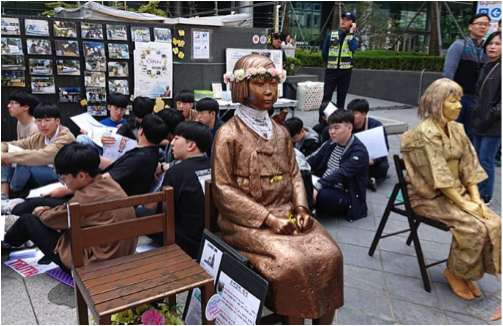
Copyright © NPO World Friendship Center 2019 All Rights Reserved
